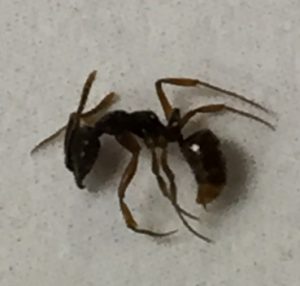How to Identify Asian Needle Ants

If the ants are up to half an inch long, they may be black carpenter ants. If they’re in great number and extremely small, they might be Argentine ants, which can only be identified via microscope. If the ants are red and located in mounds of soil or dirt outside, then they are probably fire ants, and you should probably stay away because they can sting! If the insect gives off a slight coconut odor when crushed, then it is probably an odorous house ant.
It is very important to know which ant species you have since their habits and food preferences vary greatly.
Ants are now among the most important pests both residentially and commercially.
This is due to their mere presence as a nuisance pest.
Where Do Asian Needle Ants Come From?

Colonies range in size from 39 to those with over 5,700 workers, and they have up to about 40 queens per colony. The average colony size is about 1,000 workers with an average of about 12 queens. Colonies usually consist of a single nest, but a fair number of colonies in urban areas occupied several nests.
May, June, and July are the peak months to see Asian needle ants. Females swarmers and workers are the problems because they can sting. Their stinger is very-well developed and delivers a protein-rich venom. About 80% of sting victims experience only a local reaction including swelling and redness at the sting site.
Where do you See Asian Needle Ants?
Most colonies are found in urbanized areas around buildings and associated landscaping. Nests and their galleries are always associated with kind of objects such as logs, bricks, and boards. Their preferred nesting sites are in dark, damp environments.
Feeding Preferences of Asian Needle Ants
Asian needle ants feed on dead insects, fish scraps, and decaying fruit. They prey on live anthropods, including termites. They do not recruit nestmates to a food source.
Do-it-yourself ways to reduce the conditions that harbor and attract the Asian needle ant:
- Trim tree and shrub branches off of structure
- Remove dead trees, damaged post, logs and stumps
- Seal gaps around doors and windows
- Repair foundation cracks
- Clean gutters and downspouts of debris
- Clean garbage cans
- Move garbage cans 25 feet from structure
- Clean all pet food dishes and remove spilled pet food
- Repair all leaks in structure
- Seek professional assistance and a pest prevention plan
Economy Exterminators’ Pest Control Solutions program uses the 4-step approach to solve your Asian needle ant pest problem:
- Our 1st step is the inspection of the property by a customer service specialist. It is very important to know the species involved and the severity of the pest problem. There are many areas that our inspectors check to identify as areas that need to be treated to give the best results. These areas consist of Asian needle ant runways, dead portions of standing trees, areas of high moisture in wooden members and touching trees, etc.
- The 2nd step would be the initial treatment by a customer service specialist of all areas that the inspection revealed as critical areas. Economy Exterminators uses the newest and most effective materials to solve this pest problem quickly for you. Typical critical areas would be outside areas, fascias, storage areas, crawlspaces, and garages. On the outside, special attention will be applied to all the windows, doors, eaves and the foundations. Special time and effort will be spent locating ant trails and nests.
- The 3rd step is a 37-point inspection of your property to identify areas on your property that give the Asian needle ants easy access by either direct access (cracks in the foundation) or food sources that would be attractive to this type of ant.
- The 4th step is an ongoing maintenance program for the next generation. New infestations will be moving onto your property from the adjoining property. Our exclusive Pest Control Solutions program is designed to prevent the next generation at your property in the Raleigh, Durham, Chapel Hill, Wilmington or Charlotte area.




